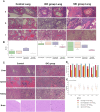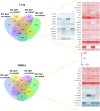Respiratory transmission potential of severe fever with thrombocytopenia syndrome bunyavirus: evidence from intranasal exposure in a humanized mouse model
- PMID: 40407816
- PMCID: PMC12180321
- DOI: 10.1080/22221751.2025.2511134
Respiratory transmission potential of severe fever with thrombocytopenia syndrome bunyavirus: evidence from intranasal exposure in a humanized mouse model
Abstract
Severe Fever with Thrombocytopenia Syndrome Bunyavirus (SFTSV) is a highly lethal pathogen with expanding endemic regions in Asia. While primarily transmitted by ticks, recent evidence suggests potential airborne transmission, raising significant public health concerns. This study investigates the potential for respiratory transmission and pathogenesis using humanized NCG mice inoculated with SFTSV via subcutaneous injection challenge (SIC) or intranasal drop challenge (IDC). Both groups demonstrated rapid systemic dissemination, marked by viremia, weight loss, and multi-organ injury, with hemorrhagic manifestations observed in high-dose infection groups. Histopathological evaluations revealed lung pathology in the intranasal drop challenge mice, including extensive alveolar disruption and inflammatory cell infiltration. Transcriptomic analyses further confirmed that respiratory route inoculation resulted in heightened expression of inflammatory signalling pathways such as IL-17 and NF-κB, potentially contributing to severe local immunopathology. Subcutaneous infection provoked an earlier systemic immune response, with significant upregulation of antigen-processing genes in peripheral blood mononuclear cells. Nevertheless, both routes ultimately culminated in widespread injury to the liver, spleen, kidney, highlighting the systemic nature of SFTSV pathogenesis. These findings underscore the need for preventive strategies addressing respiratory spread.
Keywords: SFTSV; humanized mouse model; intranasal drop challenge; next-generation sequencing; respiratory transmission potential.
Conflict of interest statement
No potential conflict of interest was reported by the author(s).
Figures





Similar articles
-
Exploring Routes of Infection of Severe Fever with Thrombocytopenia Syndrome Virus Using Experimentally Infected Animals.Am J Trop Med Hyg. 2025 Feb 25;112(5):1036-1039. doi: 10.4269/ajtmh.24-0731. Print 2025 May 7. Am J Trop Med Hyg. 2025. PMID: 39999459
-
The release of NETs during SFTSV infection downregulates the specific inflammatory factors that lead to liver and spleen damage.J Leukoc Biol. 2025 Jun 4;117(6):qiaf053. doi: 10.1093/jleuko/qiaf053. J Leukoc Biol. 2025. PMID: 40275780
-
Age-associated immune dysregulation and B cell dysfunction drive severe outcomes in SFTSV infection.PLoS Pathog. 2025 Aug 12;21(8):e1013402. doi: 10.1371/journal.ppat.1013402. eCollection 2025 Aug. PLoS Pathog. 2025. PMID: 40794649 Free PMC article.
-
Bandavirus dabieense: A review of epidemiology, clinical characteristics, pathophysiology, treatment and prevention.Virulence. 2025 Dec;16(1):2520343. doi: 10.1080/21505594.2025.2520343. Epub 2025 Jun 17. Virulence. 2025. PMID: 40519175 Free PMC article. Review.
-
Latest advances and prospects in the pathogenesis, animal models, and vaccine research of severe fever with thrombocytopenia syndrome virus.Front Immunol. 2025 Jun 26;16:1624290. doi: 10.3389/fimmu.2025.1624290. eCollection 2025. Front Immunol. 2025. PMID: 40642074 Free PMC article. Review.
References
MeSH terms
LinkOut - more resources
Full Text Sources
Other Literature Sources
